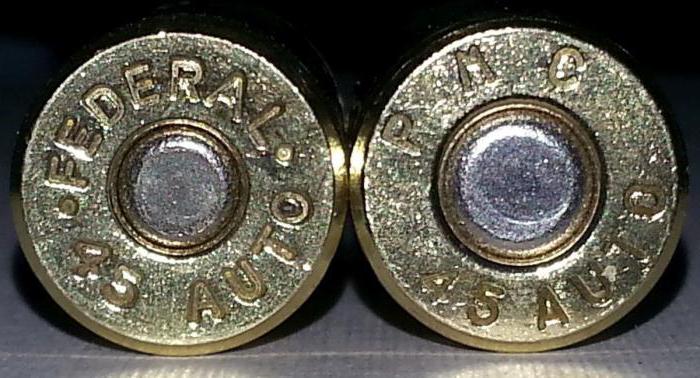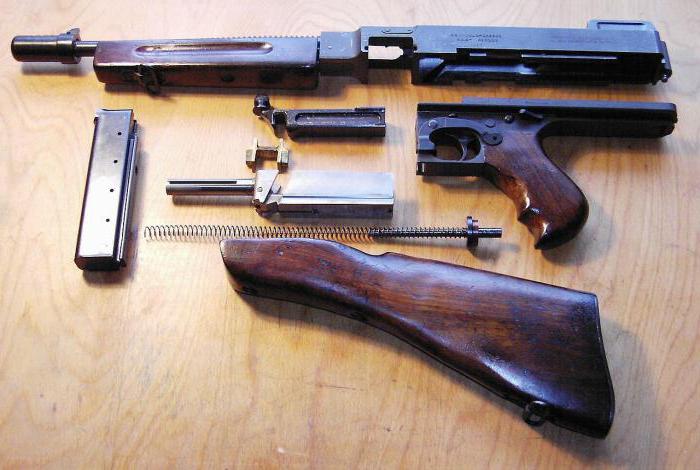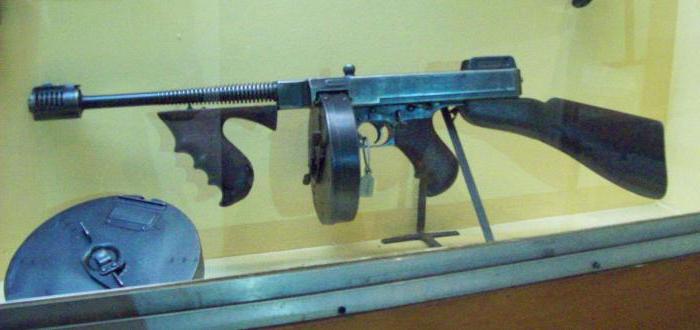“Chicago piano”, “trench broom”, “diabolical death machine” and “engine of trade” were called gangsters and military legendary creation of an American retired colonel, army supply and experienced businessman John Toliver Thompson. The automatic weapons he created are listed in the documentation as Thompson's submachine gun. The model proved to be highly effective during the Second World War and in the post-war period was in great demand among police officers, criminals and civilians. The description of the Thompson machine gun and its performance characteristics is presented in the article.
The beginning of the creation of weapons
During testing of the Mosin rifle, John Thompson was invited to Russia as a weapons expert. A retired colonel realized that the future was in automatic weapons, which determined his desire to create his own automatic rifle for the American army. Before starting to design a model of a submachine gun, Thompson had to acquire a patent for the design of the shutter, invented in 1915 by John Blish. After that, the retired colonel assembled a team of like-minded people. To work, he attracted talented engineers: Theodore Eikhoff, Oscar Payne and George Gaul. Then Thompson and financier Thomas Ryan created the arms company Auto-Ordnance. In 1916, designers began to work.
Who is the author?
Some military historians have questioned Thompson's authorship of creating legendary weapons. According to them, the retired colonel is just an enterprising businessman who hired talented designers. It is these engineers, according to weapons experts, who are the authors of the product, later called the Thompson submachine gun. In addition, the American inventor John Blish, who created a semi-free bolt for automatic weapons, can be ranked among the authors. Nevertheless, most critics are convinced that without the participation of John Thompson, the machine gun would remain at the design stage.
Design work
Designing and testing weapons took over two years. As a result of testing, it became clear to the developers that the shutter, equipped with a bronze moderator in the form of the letter “H”, is prone to very fast abrasion. The shutter, invented by John Blish, used the friction force of a bronze liner that moved inside its skeleton. As a result, at the time of the shot, a full locking of the barrel channel was not provided. This liner only carried out the braking of the shutter in the rear position, which slowed down its operation. This design feature imposed certain restrictions on ammunition. For such a shutter design, the only then standard low-power army pistol cartridge ACP45, manufactured by Colt, was suitable.

John Thompson focused his attention on it. The machine gun was developed under the army ammunition 45ASR. The need to use such a cartridge could put an end to the idea of an automatic rifle. However, an American businessman found a way out of this situation. The designers decided instead of a rifle to create a small-sized light machine gun firing pistol cartridges. Such weapons would be very effective in close range combat. Thompson's rifle product later proved to be highly effective in storming trenches and other fortifications. An American businessman called such a weapon a submachine-gun (which means: "submachine gun", "lighter type of machine gun"). This term is firmly entrenched in the English language. Today, the term submachine-gun means a hand-held automatic weapon firing pistol cartridges. In Russian, the word "submachine gun" is applicable. Its design was carried out taking into account the experience of the First World War. In total, at various times several versions of the Thompson machine gun were created. A review of the modifications of this automatic weapon can be found further in the article.
Device
In the manufacture of all models of Thompson used a scheme with a slow rollback half-free shutter. Slowing is due to friction of the N-shaped liner. The drummer in the weapon is used movable. The shutter is cocked using a special handle. The place for its location was the top cover on the receiver. The weapon is equipped with a manual fuse and an interpreter that regulates the firing mode. The fuse and translator are special levers located on the receiver on the left. As sights, the machines are equipped with flies and combined rear sights. They can be represented by diopter sights, folding up or fixed, with V-shaped slots. Effective shooting is possible at distances not exceeding one hundred meters. Ammunition is provided from box and drum stores. The box-type device is installed in the weapon from the bottom up using a special receiver. Drum shops slide into vending machines on the side. According to military experts, this method of ammunition is considered more reliable, since it provides better fixation of the drum.

First result
In 1919, the first version of the Thompson machine gun was released. The weapon was called the “Destroyer,” or “Annihilator,” and was handed over for testing by the military on the last day of World War I. Tests have shown that the machine has a reliable design and has a high rate of fire: within one minute, up to one and a half thousand shots could be fired from it. However, this option, despite the presence of undeniable advantages, had several disadvantages:
- The weapon was heavy. With a fully equipped magazine, designed for 100 ammunition, the mass of the machine exceeded 4 kg.
- High price. One unit of small arms could be purchased for $ 250. In those years, a car cost no more than 400. The high price of this weapon was due to the fact that high-precision metal-cutting machines equipped with solid blanks were used in the manufacture of parts. In addition, in order to prevent corrosion processes, the manufacturer applied silver coating to the barrel of the Thompson machine gun.
TTX
The dimensions of the Thompson machine gun of 1919 are as follows:
- The length of all weapons is 808 mm.
- Barrel length - 267 mm.
- 75-100 m - an indicator of effective shooting with this model of the Thompson machine gun.
- Caliber - 11.43 mm.
About the first batch of weapons
The 1919th was the year of the release of Thompson's first industrial batch of weapons. Since the merchant had not yet set up its own production at this time, Colt plants were involved in the manufacture of automatic machines. The first serial production was presented 15 thousand units of small arms.
About the M1921 assault rifles
In 1921, a modified batch of Thompson machine guns was launched. Assault rifles have a slower rate of fire. Within a minute, no more than 800 shots can be fired from M1921. The shooter can control the fire using the front vertical handle. The trunks are equipped with special concentric ribs to ensure their rapid cooling. In addition, muzzle compensators were developed for machine guns, which positively affected the accuracy of the battle. A model with an empty magazine weighs almost five kilograms.

The size of the entire weapon is 83 cm, the barrel is 267 mm. Model shoots a pistol cartridge 45ASP. Ammunition is carried out from box stores, with a capacity of 20 and 30 ammunition, or drum-type stores. Their capacity is from 50 to 100 rounds. Shooting from this version of Thompson's weapon is effective at a distance of 75 to 100 m. For the purpose of advertising this model was given the name "Tommy Gun", which over time has become used for almost all shooting products manufactured by Auto-Ordnance.
About the M1923 model
In 1923, Auto-Ordnance designers launched the Tommy Gun military model. Weapons are characterized by the presence of a flat forearm. An additional handle in this embodiment is missing. Ammunition is carried out from a box store, the capacity of which is 20 ammunition. According to military experts, the M1923, equipped with such a store, has less weight and is very convenient when reloading. In addition, the shooter had the opportunity, equipping weapons with a bayonet, to use the M1923 in hand-to-hand combat. The accuracy of the shots was improved thanks to special bipod mounted on the machine. In order to increase the effective firing range, the designers decided to use a new, more powerful cartridge - 45 Remington-Tompson. The “old” drum shops with a capacity of 50 and 100 ammunition are also suitable for this model. However, despite the presence of many advantages, the American military did not show interest in the M1923. Weapons were also tested in Europe. However, there M1923 did not interest any of the potential buyers. This version of Tommy Gan has remained a commercially unsuccessful version.
Shooting Products 1927-1928
In 1927, the arms manufacturer Auto-Ordnance assembled the M1927, a new version of the Thompson machine gun. The characteristics of this model were similar to the M1921. However, a special muzzle brake compensator was developed for the new weapon.
In 1928, the American manufacturer released the Navy model - a naval model. The Thompson submachine gun of 1928 is equipped with a finned barrel, on which a muzzle compensator is installed. The weapon has a slower rate of fire. Within one minute, only 700 shots can be fired from the machine gun. You can operate the Thompson machine gun of 1928 in two modes. The weapon may have a wooden horizontal fore-end or a vertical front handle. For the needs of the US military, this model of the machine was supplied under the index M1928A1. Army models were equipped with a characteristic simplified pillar design and were distinguished by the absence of barrel fins.
About model M1
By 1943, Auto-Ordance had produced a new model of small arms. This option is a significantly improved Thompson machine gun in 1928. For M1 automatic control with a free shutter and a wooden forend are provided. The charging handle is located on the receiver on the right. Muzzle compensator and barrel finning in M1 are absent. Ammunition of weapons is carried out from box stores. Model shoots a pistol cartridge 45ASP. The mass of weapons without ammunition is 4.78 kg. The length of the machine is not more than 81 cm, the barrel is 267 mm. M1 is characterized by a low rate of fire.
Within one minute, up to 900 shots can be fired. Ammunition is carried out from box-type stores. Their capacity is 20-30 ammunition. Shooting from an M1 machine gun is effective at a distance of 75 to 100 m.
M1A1
The weapon designers of Auto-Ordance released an even more simplified Thompson rifle model. In the machine, the cross over sight was replaced by an unregulated diopter. In the armies of the United States and other European states, submachine guns were not considered a powerful military weapon. However, in 1928, the United States Marine Corps purchased several thousand of these units. Since, according to military experts, the use of this model of a submachine gun was limited, American soldiers never had the chance to get acquainted with the true capabilities of this weapon.
The situation radically changed with the beginning of the Second World War. Due to the rapid development and growth of armored vehicles of tank and motorized infantry troops, a need arose for such a compact automatic weapon as the M1A1. Mass production of submachine guns was carried out by Auto-Ordnance and Avage Arms Corp. Released small arms were used by rangers, paratroopers and military intelligence. Although Thompson's machine guns, (photo of the models presented in the article) were heavy and bulky, they were very popular on all fronts of the Second World War. During the years 1940-1944, American industry produced M1928A1- 562,511 units, M1- 285,480 and M1A1- 539,143.
Post-war time
At the close of World War II, John Thompson was on the verge of bankruptcy. A businessman was trying to find buyers for his products in the US police. A retired colonel created the Anti-bandit gun. At first, the American police did not show interest in “anti-bandit weapons.” The situation changed dramatically after the "Prohibition" came into force and the criminals engaged in the smuggling of alcohol. Canada became the state from which large quantities of alcoholic products came to America. Such a business brought gangs huge profits. Between various groups bloody wars began over spheres of influence. Crime has become organized. To eliminate competitors, Thompson's submachine guns proved to be highly effective. It was from this time that this weapon began to be called the "engine of trade." Wanting to adequately confront criminals, US law enforcement officers also armed with these machine guns. So the submachine gun came into the service of the US police. Rifle models were used both by police to eliminate bandits, and by criminals - to conduct bloody "gang wars".

This weapon was also used by agents of the FBI, the US Coast Guard and the postal service. Thompson pistols served in government until 1976. Then these models were considered obsolete and were withdrawn from service.
About the advantages and disadvantages
According to military experts, Thompson submachine guns are characterized by high reliability and workmanship. However, the production of weapons itself requires large financial investments. This determines the high cost of machines. Their disadvantages include also large weight and bulkiness. In addition, a bullet fired from such weapons has a great flight steepness, which led to the restriction of the use of these models in the army.
About sports models
For the needs of the civilian population, the Auto-Ordnance weapons company produced the following submachine gun models:
- M1927A1. It is a self-loading version of the machine. Consumers also call this model "Thompson self-loading carbine." Unlike the early 1927 model, the civilian variant shoots with the shutter closed. M1927A1 was produced during the years 1974-1999.
- M1927A3. It is a self-loading variant using 22-caliber ammunition.
- M1927A5. It is a self-loading model using 45ACP pistol cartridges. Wanting to reduce the weight of civilian weapons, designers equipped it with aluminum parts. In addition, the barrel length in this weapon is not 10 inches, but 5.
- 1927A1 Lightweight Deluxe Pistol TA5. It is a replica of the model 1927 release. The barrel length in civilian weapons is shortened and is 266 mm. Butt for the product is not provided. It shoots pistol cartridges 45ACP. Ammunition is carried out from a disk store with a capacity of 50 ammunition. This civilian model was released in 2008.
Our days
At one time, pistol-guns of the legendary retired colonel were very popular among representatives of the Cosa Nostra and other gangs. Thompson used rifle products from 1921 to 1970 in the Irish Republican Army. Literary and artistic works, films and computer games today are the area in which the most frequently mentioned Thompson submachine gun.
Toys created on the basis of legendary weapons are in great demand among children. The production of such products is established all over the world. Judging by the numerous consumer reviews, the children really like the Thompson pneumatic machine gun. The toy is made in the form of a legendary assault rifle. The material for it was durable plastic. Shoots children's weapons with 6 mm plastic bullets. A laser sight is provided for the product.